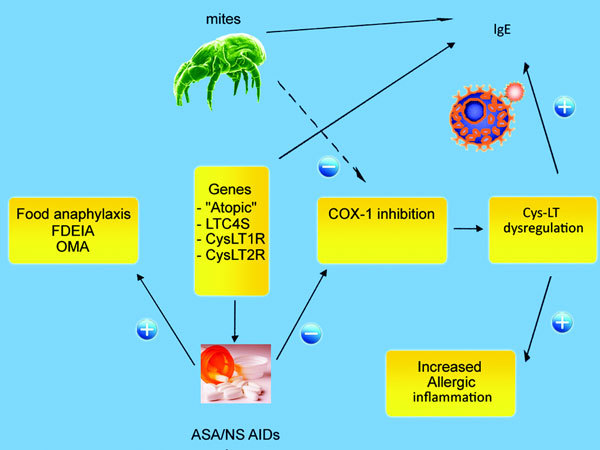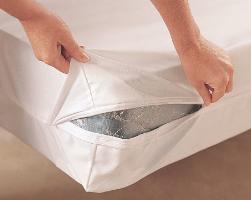
We’re being INVADED!
Dust mites live in everyone’s houses.
These little bugs are everywhere: on your bed, your pillow, on the floor, teddy bears, carpets and even on your clothes right now.
Dust mites are the leader of allergy, especially asthma and eczema.
Are you sensitive to it? Or risk it pretending you don’t care?
Dust Mites Basics
Dust mites (Dermatophagoides) have existed 60 million years ago, and today several of its million species love living in human homes.
They are 75% water. No eyes, no respiratory tract. They rely highly on the sense of smell.
They feed on: fungi, bacteria, animal dander and dead human skin cells. And don’t need water to survive because they can just absorb moisture from the air.
Where do dust mites reside?
- Tobacco
- Cigarette ash
- Incinerator ash
- Combustion products
- Synthetic textiles
- Fibers: wool, cotton, paper and silk
- Human: fingernail filings, hair
- Animal, insect dander
- Plant parts including pollen
- Soil
- Wood shavings
- Food crumbs
- Glass particles
- Glue
- Graphite
- Stone particles
- Oil soot
- Paint chips
- Polymer foam particles
- Salt and sugar crystals
- Fungal spores
(Source)
While they are invisible to the naked eye, they average around 100-500 mites per gram of dust (in some cases up to 19,000 mites/g).
Importance of Dust Mites
 Why are dust mites so important?
Why are dust mites so important?
Dust mites are important because they are an extremely common cause of allergic reactions – trigger for inflammatory responses. It’s asthma’s number one killer.
For us people who suffer from eczema, many of us may be sensitive to it without acknowledgement.
While dust mites may not be a critical allergen for everyone, it does not necessarily mean no one has abnormal immune responses towards this bug.
Research 1 (on asthma):
“In addition to genetic factors, exposure in early childhood to house-dust mite allergens is an important determinant of the subsequent development of asthma.”
Asthma, just like eczema, is closely linked under the same chronic branch. If you have either one, make sure you take action against all possible disease factors or you risk the chance of developing new abnormal autoimmune diseases.
Research 2 (on eczema):
“Tests completed on people with atopic dermatitis (eczema) demonstrate that the reduction of mite allergens improved the condition, greatly reducing the activity of atopic dermatitis in some people. There is a need to identify the people who will gain from this intervention.”
If you suffer from eczema, I’m sure you would look for all possible ways to cut down your flare-ups to the bare minimum. Dust mites may not be your number one factor, but eliminating them will definitely help you outright.
Research 3 (highest IgE proportions):
“The highest levels were to house dust mite, exceeding 1000 RAST units in 13 subjects.”
1 RAST unit is approximately equivalent to 1 IU total IgE. Normal IgE levels in the blood should be low – the upper limit ranges around 150-300 UI/ml.
A heightened level of IgE levels indicates an abnormal immune response e.g. infection, allergic reactions, autoimmune disease and cancer. According to the research above, the subjects who were tested with HDM were reported with extremely higher IgE levels. This undeniably shows that house dust mites can trigger your symptoms directly and significantly.
Research 4 (pancake syndrome):
“Oral mite anaphylaxis is a new syndrome characterized by severe allergic manifestations occurring in atopic patients shortly after the intake of foods made with mite-contaminated wheat flour.”

Pancake syndrome is named this way because the contamination of dust mites leading to anaphylaxis is commonly triggered through the consumption of pancakes.
While this research may be less relevant to eczema sufferers, it is to inform you that dust mites may be tiny but they could cause fatality even after cooking. However, the pancake syndrome is rare so don’t worry about it.
For the best, the study recommends:
“To prevent mite proliferation and the production of anaphylaxis, it has been recommended that wheat flour be stored at low temperatures in the refrigerator.”
As you can see, house dust mites are microscopic and deadly. For us eczema sufferers, it is one significant allergen that we should be completely aware of.
If you want to promote the fastest recovery and find out all possible causes of your eczema, dust mite sensitivity should be one of your first considerations.
Symptoms of HDM Sensitivity
The problem about dust mites is, our immune system doesn’t like them.
Here are typical symptoms of sensitivity to house dust mites:

- Itchiness
- Rashes
- Cough
- Sneezing
- Crazy sneezing
- Eye getting watery or red
- Runny nose
- Breathing difficulties
- Lung congestion
- Nasal congestion
- Hay fever
- Facial pressure and pain
As symptoms may vary amongst individuals it could get rather difficult to identify whether HDMs are contributing to your symptoms.
To identify this means you will need to eliminate the HDMs in order to see the difference; 100% elimination is impossible but they can be greatly reduced (explained next).
For me, my frenzy of sneezing every single morning after waking up (10+ sneezes) gave me the clue and, as soon as I left Hong Kong my sneezes instantly stopped. There’s the cause and effect.
Elimination of HDMs

So, how do you get rid of the mites?
You can’t kill every single one of them, but you can take steps to greatly cut down their numbers.
While you may be sensitive to dust mites, even if you can remove every single one of them does not necessarily mean you’ll be safe. Why?
Because dust mites excrete about 20-25 waste droppings a day, and within those substances contain their special protein – and that gets us sensitive.
Here’s how you can drop their numbers:
- Use a mite-proof pillow case and mattress cover. These not only help reduce the accumulation of human shed skin, they are also water-proof.
- Wash your bedware under hot water at 60 degrees once every 1-2 weeks.
- Use organic synthetic materials. The key factor that showed whether a fabric was able to block out allergens was pore size, the smaller the better. This way, mites will have fewer places to “homestay”.
- Don’t use hairy fabrics like carpets and rugs, they encourage build-ups of mites.
- Consider getting a high-quality air purifier, good ones can filter up to 99% of unwanted substances, including dust mites and other potential allergens.
- Wet-dust your household at least once per week, dry dusting will cause dust particles and debris to circulate in the air which is a big no-no.
- Vacuum your house regularly.
- Open the windows to allow air to circulate throughout the house.
- House dust mites thrive best under the conditions of 25°C and relative humidity >70%. Use the appropriate appliance to go against these two optimal conditions.
- To prevent food infestation by mites, seal them in a plastic container and put it in the freezer.
Here’s more information.
Here are two studies for you to dwell into about how mite population can be highly reduced with encasement. Seriously, you need the mite-proof cases and covers!
“Encasing of mattresses and pillows resulted in a significant long-term reduction in allergen concentrations in mattresses and in the need for inhaled steroids in children with asthma and House dust mite allergy.”
“Mite population and allergen levels decreased by 90% or more within a month of placing mattress and pillow covers and treating bedding.”
Here’s a fact sheet on dust mites from the National Eczema Organization.
To Eczema Sufferers: Actions To Take
HDMs are more of a big deal to asthma sufferers.
But that doesn’t mean people with eczema shouldn’t care, as both diseases are linked together as abnormal immune responses. And there is evidence that suggest dust mites are a common allergen in eczema.
You could be sensitive to this tiny bug and it is one of the factors contributing to your flare-ups. It may not affect you strong enough to realize it, and this can be a hidden problem.
So, what should you do?
Minimize all possible traces of dust mites in your household.
Right now.
Nice and informative article, makes you a bit sick if you think about the swarms of dust mites living in our homes. As you suggest, keep your home clean which is common sense and you are one step ahead of the battle against them.
Thanks, yeah it is quite disturbing. That is common sense but some places are hard to keep them out because of high humidity like HK.
Hey mate.
Oh my god! I just had my meal >.<
Hey, those are disgusting but thanks for sharing. Yes I know it isn't my niche but…nice to read something 'different' 🙂
Reginald
Hey Reginald, aha yeah they are disturbing once you know how much of them reside in your sleep. Thanks.
there some kind of might that’s burrows into your skin how doi get rid of these little basterds